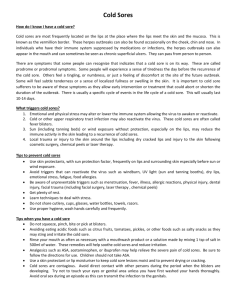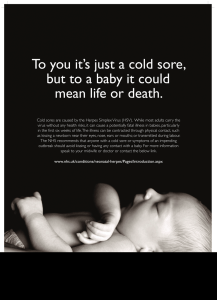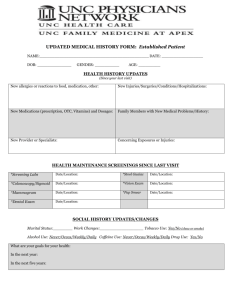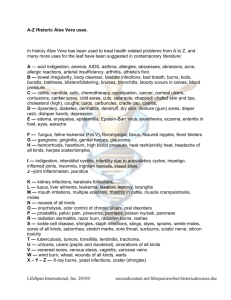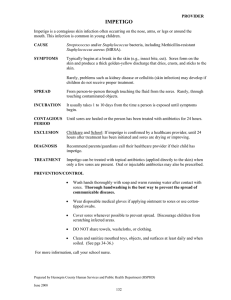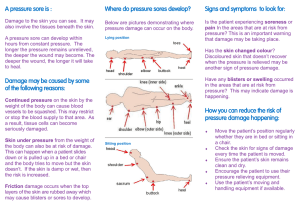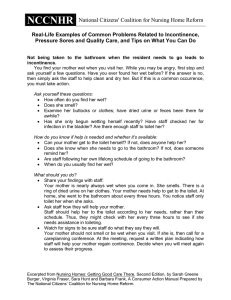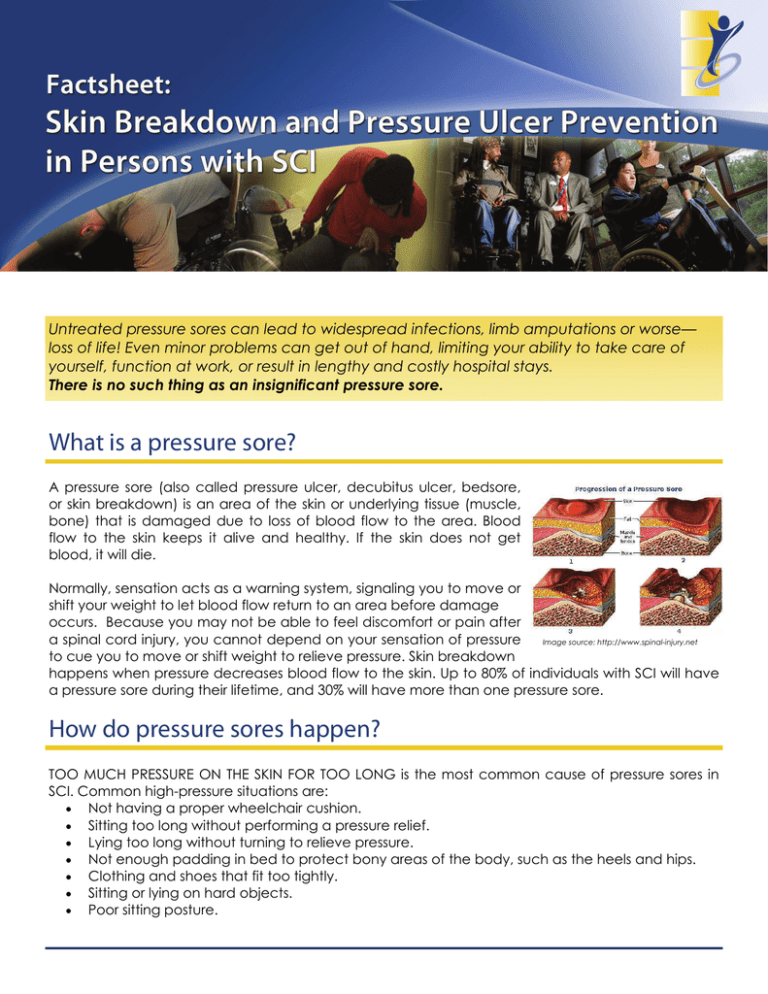
Untreated pressure sores can lead to widespread infections, limb amputations or worse—
loss of life! Even minor problems can get out of hand, limiting your ability to take care of
yourself, function at work, or result in lengthy and costly hospital stays.
There is no such thing as an insignificant pressure sore.
What is a pressure sore?
A pressure sore (also called pressure ulcer, decubitus ulcer, bedsore,
or skin breakdown) is an area of the skin or underlying tissue (muscle,
bone) that is damaged due to loss of blood flow to the area. Blood
flow to the skin keeps it alive and healthy. If the skin does not get
blood, it will die.
Normally, sensation acts as a warning system, signaling you to move or
shift your weight to let blood flow return to an area before damage
occurs. Because you may not be able to feel discomfort or pain after
a spinal cord injury, you cannot depend on your sensation of pressure
Image source: http://www.spinal-injury.net
to cue you to move or shift weight to relieve pressure. Skin breakdown
happens when pressure decreases blood flow to the skin. Up to 80% of individuals with SCI will have
a pressure sore during their lifetime, and 30% will have more than one pressure sore.
How do pressure sores happen?
TOO MUCH PRESSURE ON THE SKIN FOR TOO LONG is the most common cause of pressure sores in
SCI. Common high-pressure situations are:
Not having a proper wheelchair cushion.
Sitting too long without performing a pressure relief.
Lying too long without turning to relieve pressure.
Not enough padding in bed to protect bony areas of the body, such as the heels and hips.
Clothing and shoes that fit too tightly.
Sitting or lying on hard objects.
Poor sitting posture.
Besides pressure on the skin, other factors increase your risk of forming pressure ulcers too:
Decreased circulation, due to:
Smoking,
Diabetes,
High blood pressure.
Poor positioning & poor cushion support.
Physical activity that increases repetitive pressure over an area vulnerable to breakdown or
causes excessive perspiration (sweat) in a vulnerable area.
Shearing of the skin.
Poor nutrition & dehydration.
Aging - as you age your skin will become thinner and more vulnerable to injury.
Being over- or underweight.
Loss of muscle mass that previously would have provided a natural cushion over the bony
areas of your body (such as heels, hips, and tailbone, also known as the “sacrum”).
Moisture - wet skin (from urine, stool , sweat, water) is more likely to break down.
Dry, flaky skin can crack and become inflamed and infected.
Circulation
Poor circulation can lead to pressure sores and other skin problems. Some of these problems are
increased sensitivity, scrapes or bruises that take longer to heal, and chaffing due to excess moisture
or sweating. Without enough blood, oxygen, and nutrients, your skin can’t stay healthy.
Sitting or lying in one position for a long period of time decreases blood
circulation to the areas supporting your body weight. Pressure sores usually form on parts of the skin close to bone (such as hips and heels) that
carry weight when you sit or lie down for a long time.
Swelling or “edema”– often a side effect of paralysis – leaves skin more
vulnerable to injury and breakdown. Elevate your legs a few times a
day as well as your arms. Support socks/stockings can also help with
swelling, however it’s best to consult a doctor or nurse regarding foot care and footwear.
Smoking reduces circulation and makes you prone to frequent pressure sores because it dries out
the skin. It also increases your risk of respiratory infections such as pneumonia and bronchitis. So,
whether you are a heavy or light smoker, the effects on your body are still very harmful!
Find out more by reading, “Smoke? STOP!!” at:
http://www.spinalcord.uab.edu/show.asp?durki=108408.
The Importance of Positioning
About 75% of your body’s weight is concentrated on your buttocks when you sit upright
(MedlinePlus, 2009). Although wheelchair cushions reduce pressure, good skin care and positioning
are the most important part of preventing sores. Areas of your body where you are very likely to develop a pressure sore when you are in your wheelchair are:
Your tailbone or buttocks,
Your shoulder blades and spine,
The backs of your arms and legs where they rest against the chair,
Your heels.
Positioning
Changing positions frequently is key in preventing skin breakdown. Having a schedule for changing
positions is one of the best ways to help prevent pressure sores. When in your chair, pay attention to
your posture; slouching puts more pressure on the lower back and tailbone (sacrum) areas. In a
seated position, try to maintain a 90-degree (right) angle between your upper body and your hips.
When sitting in your wheelchair, you should do pressure reliefs every 15 to 30 minutes. In bed, you
can reduce pressure by placing pillows under and between your legs, and a general recommendation is to change positions every two hours when in bed.
Tips for Changing Positions
Perform weight shifts every 15-30 minutes while sitting.
Turn or reposition at least every two hours while in bed.
Use pillows under and/or between legs when lying in bed to keep bones
from rubbing together.
Avoid lying directly on the hip bone and keep a 30-degree angle position.
When lying on your back, keep your lower legs up by placing a thin foam
pad or pillow under the lower part of the legs (mid-calf to ankle). Do not
place the pad or pillow directly under the knee—this reduces the flow
of blood to the lower leg areas.
Use pillows or small pads to keep the knees and ankles from touching each
other.
The Importance of Staying Active and Eating Healthy
Physical Activity
Physical activity has many health benefits and is important for your
health and circulation. However, excessive sweating and moisture resulting from exercise make you an easy target for skin breakdown. When
exercising, use towels for excess sweat and wear lightweight or loose
clothing to help skin breathe. Don’t stay in wet clothing after exercising.
Pay close attention to your skin’s reaction to things like lotions, powders,
or fragrances.
Nutrition
You already know that SCI changes your body composition and the way your body uses food. Because of these changes, fewer calories are needed, so you should really try to make those calories
count. Try to eat a consistent and balanced diet. Don’t skip meals or cut out certain food groups.
Poor diet increases your risk of pressure sores and will make it more likely to have recurring pressure
sores, more difficulty with healing, and more severe infections. Poor nutrition promotes swelling,
which is bad for circulation, and prevents oxygen from getting to cells throughout your body. Being
overweight is also risky because it’s harder to shift your weight, do pressure reliefs, and move around.
Your doctor, nurse, or a dietitian can give you advice about balancing your diet.
Hydrate
Drink Water!!
You need lots of water! If you’ve got a wound or sore, you can lose more than 4
cups of water each day, just as part of the healing process! Hydration is also key
to maintaining healthy circulation and skin health. While 6-8 cups may be recommended for someone on a catheterization program, others might need more
than that. Ask your doctor how much water is right for you.
Also, if you're losing fluids from an open sore -- or for any other reason -- you'll need
to increase your water intake even more and avoid drinking alcohol.
If you do choose to drink alcohol, use it in moderation. Excessive alcohol consumption often leads to
dehydration and can prevent your body from effectively using food and vitamins.
Good Eats
A healthy well-balanced diet is important:
Proteins: Lean meats, eggs, dairy foods, and beans and legumes help
maintain skin elasticity.
Carbs: Complex carbs (carbohydrates) like fruits, vegetables, and whole
grain breads and cereals give you the calories you need for energy,
nourishment, and wound healing. Simple carbs include refined flours
and sugars and are more fattening and negatively affect your health.
Zinc: Found in foods like fish, red meats, whole grains, and beans, zinc is crucial for skin repair because it helps metabolize carbohydrates, fats, and proteins.
Vitamins: Both Vitamins A and C increase skin’s strength. Vitamin A is found in dark green and orange vegetables; cantaloupe, and milk. Vitamin C is found in citrus fruits and many vegetables. Talk to a doctor before taking vitamins or supplements and be careful of overdose! Beware that too much vitamin A can be toxic (poisonous).
General Health
Your physical health affects your skin. If you’re sick, every part of your body can be affected. Fevers
change your metabolism (i.e. how your body manages energy), alter skin tolerance, and lower your
body’s infection resistance. Bladder infections don’t just affect your bladder; ear infections don’t just
affect your ears. Remember to check your skin at least twice a day for signs of breakdown because
loss of sensation can make it hard to perceive pressure and pain. If you’ve been sick or hospitalized,
muscle atrophy (getting smaller) and weight loss can occur quickly. When this happens, you have
less fat and muscle that help cushion your bones and your risk of pressure sores increases.
Take Home Tips:
Remember That...
You should check your skin at least twice a day.
You should change body positions every 2 hours when in bed.
You should do pressure reliefs in your chair every 15-30 minutes.
Try to maintain good posture and avoid positions that allow you to slide or slump.
Avoid sliding when transferring on surfaces (e.g., from the wheelchair to bed)—this causes
friction that can lead to skin abrasions.
Smoking greatly increases your risk for pressure sores as well as many other health issues.
As you age with your injury, you are more susceptible to pressure sores and skin breakdown.
Good hygiene, nutrition, and attitude make all the difference in your health.
You should inspect your equipment often and periodically get your equipment reassessed by
a rehabilitation professional.
Sources:
MedlinePlus Medical Encyclopedia: Pressure Ulcer (Online). [Accessed 12/20/2010]: http://www.nlm.nih.gov/medlineplus/ency/article/007071.htm
Modelsystems Knowledge Translations Center (MKSTC). SCI Skincare and Pressure Sores. [Accessed 12/20/2010]: http://msktc.washington.edu/sci/
factsheets/sci_factsheets.asp#skin
For more information or alternative formats, please visit our web site at:
http://www.sci-health.org or call 1-877-278-0644.
Disclaimer
This fact sheet only provides general information. It is only for informational and educational purposes and should not be used to diagnose
or treat a medical condition. It is not a substitute for professional medical advice relative to your specific medical conditions. Always seek
the advice of your doctor or other qualified health provider before starting any new treatment or with any questions you may have about
your medical condition.
Copyright © 2012 RRTC on Spinal Cord Injury - All Rights Reserved
Funded by the National Institute on Disability and Rehabilitation Research (NIDRR), U.S. Department of Education. Grant #H133B090002.

